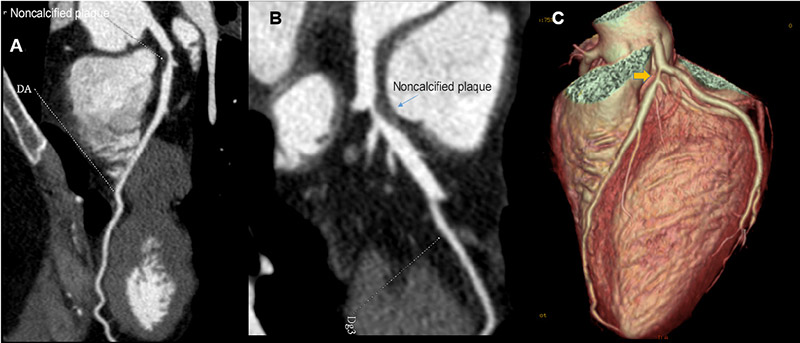Volume 110, Nº 5, May 2018
DOI: http://www.dx.doi.org/10.5935/abc.20180063
ORIGINAL ARTICLE
Atherosclerotic Plaque in Patients with Zero Calcium Score at Coronary Computed Tomography Angiography
Fabíola Santos Gabriel
Luiz Flávio Galvão Gonçalves
Enaldo Vieira de Melo
Antônio Carlos Sobral Sousa
Ibraim Masciarelli Francisco Pinto
Sara Melo Macedo Santana
Carlos José Oliveira de Matos
Maria Júlia Silveira Souto
Flávio Mateus do Sacramento Conceição
Joselina Luzia Menezes Oliveira
Dr. Luiz Flávio Galvão Gonçalves

Figure 1 – Noncalcified plaque with zero calcium score. Thirty-eight-year old woman; A and B) multiplanar reconstructions showing considerable lumen reduction in anterior descending artery (DA); C) Tridimensional reconstruction showing impairment in DA (yellow arrow).
Abstract
Background: In view of the high mortality for cardiovascular diseases, it has become necessary to stratify the main risk factors and to choose the correct diagnostic modality. Studies have demonstrated that a zero calcium score (CS) is characteristic of a low risk for cardiovascular events. However, the prevalence of individuals with coronary atherosclerotic plaques and zero CS is conflicting in the specialized literature.
Objective: To evaluate the frequency of patients with coronary atherosclerotic plaques, their degree of obstruction and associated factors in patients with zero CS and indication for coronary computed tomography angiography (CCTA). Methods: This is a cross-sectional, prospective study with 367 volunteers with zero CS at CCTA in four diagnostic imaging centers in the period from 2011 to 2016. A significance level of 5% and 95% confidence interval were adopted.
Results: The frequency of atherosclerotic plaque in the coronary arteries in 367 patients with zero CS was 9.3% (34 individuals). In this subgroup, mean age was 52 ± 10 years, 18 (52.9%) were women and 16 (47%) had significant coronary obstructions (> 50%), with involvement of two or more segments in 4 (25%) patients. The frequency of non obese individuals (90.6% vs 73.9%, p = 0.037) and alcohol drinkers (55.9% vs 34.8%, p = 0.015) was significantly higher in patients with atherosclerotic plaques, with an odds ratio of 3.4 for each of this variable.
Conclusions: The frequency of atherosclerotic plaque with zero CS was relatively high, indicating that the absence of calcification does not exclude the presence of plaques, many of which obstructive, especially in non-obese subjects and alcohol drinkers. (Arq Bras Cardiol. 2018; 110(5):420-427)
Keywords: Cardiovascular Diseases/mortality; Plaque, Atherosclerotic; Coronary Artery Disease/diagnosis; Calcium Signaling; Coronary, Angiotomography; Risk Factors.















